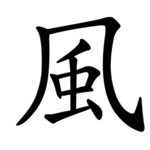Radical 182
Radical 182 or radical wind (風部) meaning "wind" is one of the 11 Kangxi radicals (214 radicals in total) composed of 9 strokes.
| 風 | ||
|---|---|---|
| ||
| 風 (U+98A8) "wind" | ||
| Pronunciations | ||
| Pinyin: | fēng | |
| Bopomofo: | ㄈㄥ | |
| Wade–Giles: | feng1 | |
| Cantonese Yale: | fung1 | |
| Jyutping: | fung¹, fung³ | |
| Japanese Kana: | フウ fū / フ fu (on'yomi) かぜ kaze (kun'yomi) | |
| Sino-Korean: | 풍 pung | |
| Hán-Việt: | phong, phông | |
| Names | ||
| Japanese name(s): | 風/かぜ kaze | |
| Hangul: | 바람 baram | |
| Stroke order animation | ||
 | ||

In the Kangxi Dictionary, there are 182 characters (out of 49,030) to be found under this radical.
In Taoist cosmology, 風 (wind) is the nature component of the Bagua diagram 巽 Xùn.
风, the simplified form of 風, is the 91st indexing component in the Table of Indexing Chinese Character Components predominantly adopted by Simplified Chinese dictionaries published in mainland China, while the traditional form 風 is listed as its associated indexing component.
Evolution
 Oracle bone script character
Oracle bone script character Bronze script character
Bronze script character Large seal script character
Large seal script character Small seal script character
Small seal script character
Derived characters
| Strokes | Characters (風) | Characters (风) |
|---|---|---|
| +0 | 風 | 风SC (=風) |
| +3 | 颩 颪JP | 飏SC (=颺) |
| +4 | 颫 颬 | |
| +5 | 颭 颮 颯 颰 颱 | 飐SC (=颭) 飑SC (=颮) 飒SC (=颯) |
| +6 | 颲 颳 | |
| +7 | 颴 颵 | |
| +8 | 颶 颷 (=飆) | 飓SC (=颶) |
| +9 | 颸 颹 颺 | 飔SC (=颸) 飖SC (=颻) |
| +10 | 颻 颼 颽 颾 颿 飀 | 飕SC (=颼) 飗SC (=飀) |
| +11 | 飁 飂 飃 (=飄) 飄 | 飘SC (=飄) |
| +12 | 飅 飆 飇 (=飆) 飈 (=飆) 飉 飊 (=飆) | 飙SC (=飆) 飚SC nonstandard (=飈=飆) |
| +13 | 飋 | |
| +18 | 飌 (=風) 飍 |
Variant forms
In the Kangxi Dictionary and modern standard Traditional Chinese as used in Taiwan, Hong Kong, and Macau, the stroke above 虫 in the radical character 風 is horizontal, while it is a left-falling stroke in other languages.
| Kangxi Dictionary Trad. Chinese (TW, HK, MO) |
Japanese Korean Trad. Chinese (Mainland China) |
Simp. Chinese |
|---|---|---|
| 風 | 風 | 风 |
Sinogram
The radical is also used as an independent Chinese character. It is one of the Kyōiku kanji or Kanji taught in elementary school in Japan.[1] It is a second grade kanji[1]
References
- "The Kyoiku Kanji (教育漢字) - Kanshudo". www.kanshudo.com. Archived from the original on March 24, 2022. Retrieved 2023-05-06.
Literature
- Fazzioli, Edoardo (1987). Chinese calligraphy : from pictograph to ideogram : the history of 214 essential Chinese/Japanese characters. calligraphy by Rebecca Hon Ko. New York: Abbeville Press. ISBN 0-89659-774-1.
- Lunde, Ken (Jan 5, 2009). "Appendix J: Japanese Character Sets" (PDF). CJKV Information Processing: Chinese, Japanese, Korean & Vietnamese Computing (Second ed.). Sebastopol, Calif.: O'Reilly Media. ISBN 978-0-596-51447-1.